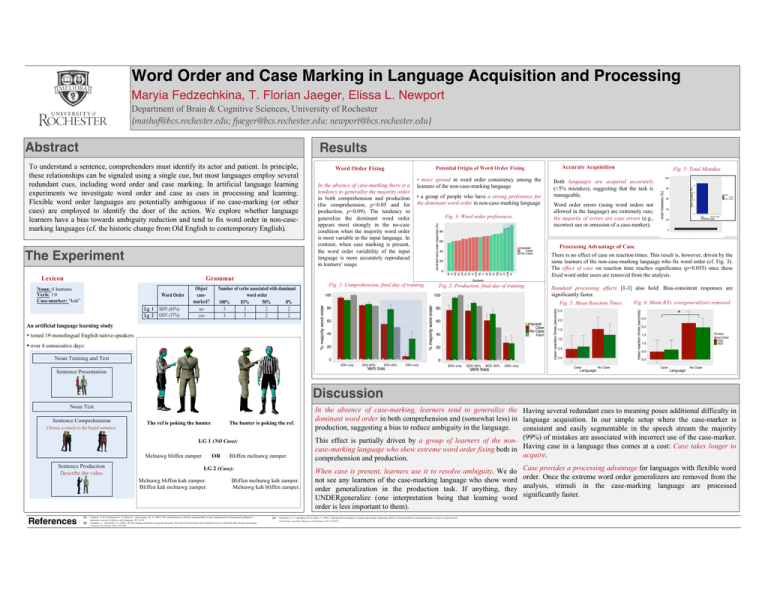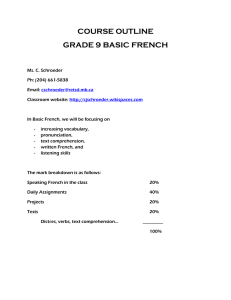Word Order and Case Marking in Language Acquisition and
advertisement

Word Order and Case Marking in Language Acquisition and Processing
Maryia Fedzechkina, T. Florian Jaeger, Elissa L. Newport
Department of Brain & Cognitive Sciences, University of Rochester
{mashaf@bcs.rochester.edu; fjaeger@bcs.rochester.edu; newport@bcs.rochester.edu}
Abstract
Results
To understand a sentence, comprehenders must identify its actor and patient. In principle,
these relationships can be signaled using a single cue, but most languages employ several
redundant cues, including word order and case marking. In artificial language learning
experiments we investigate word order and case as cues in processing and learning.
Flexible word order languages are potentially ambiguous if no case-marking (or other
cues) are employed to identify the doer of the action. We explore whether language
learners have a bias towards ambiguity reduction and tend to fix word order in non-casemarking languages (cf. the historic change from Old English to contemporary English).
The Experiment
Potential Origin of Word Order Fixing
Word Order Fixing
In the absence of case-marking there is a
tendency to generalize the majority order
in both comprehension and production
(for comprehension, p<0.05 and for
production, p<0.09). The tendency to
generalize the dominant word order
appears most strongly in the no-case
condition when the majority word order
is most variable in the input language. In
contrast, when case marking is present,
the word order variability of the input
language is more accurately reproduced
in learners’ usage.
• more spread in word order consistency among the
learners of the non-case-marking language
• a group of people who have a strong preference for
the dominant word order in non-case-marking language
Fig. 3: Word order preferences
Word Order
Lg 1
Lg 2
SOV (63%)
OSV (37%)
Object
casemarked?
no
yes
Number of verbs associated with dominant
word order
100%
83%
50%
0%
3
3
2
2
3
3
2
2
Fig. 1: Comprehension, final day of training
Fig. 5: Total Mistakes
Both languages are acquired accurately
(<5% mistakes), suggesting that the task is
manageable.
Word order errors (using word orders not
allowed in the language) are extremely rare;
the majority of errors are case errors (e.g.,
incorrect use or omission of a case-marker).
Processing Advantage of Case
There is no effect of case on reaction times. This result is, however, driven by the
same learners of the non-case-marking language who fix word order (cf. Fig. 3).
The effect of case on reaction time reaches significance (p=0.055) once these
fixed word order users are removed from the analysis.
Grammar
Lexicon
Noun: 6 humans
Verb: 1 0
Case-marker: “kah”
Accurate Acquisition
Fig. 2: Production, final day of training
Standard processing effects [1-3] also hold: Bias-consistent responses are
significantly faster.
Fig. 6: Mean RTs, overgeneralizers removed
Fig. 5: Mean Reaction Times
*
An artificial language learning study
tested 19 monolingual English native-speakers
over 4 consecutive days:
Noun Training and Test
Sentence Presentation
Discussion
Noun Test
Sentence Comprehension
Choose a match to the heard sentence
The ref is poking the hunter.
The hunter is poking the ref.
LG 1 (NO Case):
Melnawg bliffen zamper.
Sentence Production
Describe the video
OR
Melnawg bliffen kah zamper.
Bliffen kah melnawg zamper.
References
[1]
[2]
Bliffen melnawg zamper.
LG 2 (Case):
Bliffen melnawg kah zamper.
Melnawg kah bliffen zamper.
Garnsey, S. M., Pearlmutter N . J., Myers, E. , and Lotocky, M. A. (1997). The contributions of verb bias and plausibility to the comprehension of temporarily ambiguous
sentences. Journal of Memory and Language, 37, 58-93.
Snedeker, J., Trueswell, J. C. (2004). The developing constraints on parsing decisions: The role of lexical-biases and referential scenes in child and adult sentence processing.
Cognitive Psychology, 49/3, 238-299.
[3]
In the absence of case-marking, learners tend to generalize the Having several redundant cues to meaning poses additional difficulty in
dominant word order in both comprehension and (somewhat less) in language acquisition. In our simple setup where the case-marker is
production, suggesting a bias to reduce ambiguity in the language.
consistent and easily segmentable in the speech stream the majority
This effect is partially driven by a group of learners of the non- (99%) of mistakes are associated with incorrect use of the case-marker.
case-marking language who show extreme word order fixing both in Having case in a language thus comes at a cost: Case takes longer to
acquire.
comprehension and production.
When case is present, learners use it to resolve ambiguity. We do
not see any learners of the case-marking language who show word
order generalization in the production task. If anything, they
UNDERgeneralize (one interpretation being that learning word
order is less important to them).
Trueswell, J. C. Tanenhaus, M. K. K ello, C. (1993). Verb-specific constraints in sentence processing: Separating effects of lexical preference from garden-paths. Journal of Experimental
Psychology: Learning, Memory and Cognition, 19/3, 528-553.
Case provides a processing advantage for languages with flexible word
order. Once the extreme word order generalizers are removed from the
analysis, stimuli in the case-marking language are processed
significantly faster.

